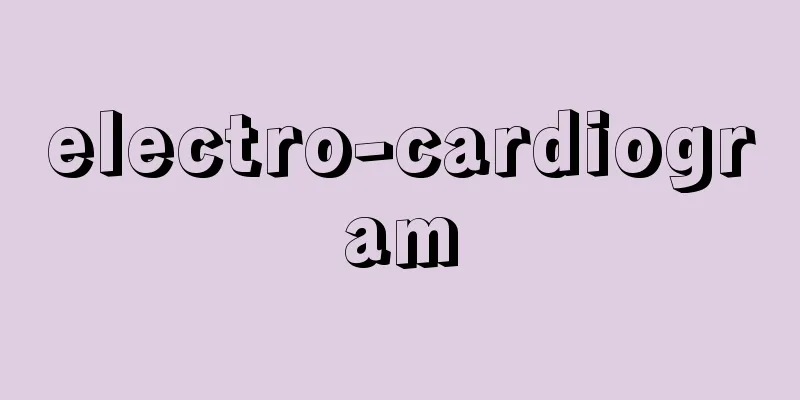electro-cardiogram

|
Electrocardiograms, which record the electrical phenomena of the heart from the body's surface, are used to diagnose anatomical abnormalities of the heart (hypertrophy, infarction, etc.) and functional changes (arrhythmia, ischemic attacks, electrolyte abnormalities, drug effects). They are essential for diagnosing arrhythmias, myocardial infarction, and ischemic attacks. However, depending on the pathology, the diagnostic accuracy is not high (electrolyte abnormalities, drug effects), and even if diagnostic criteria exist, there are limitations to the diagnostic accuracy (hypertrophy, etc.). During the process of growth from infancy to adulthood, physiological changes occur in the electrocardiogram waveform, and normal waveforms in children differ from those in adults, and various diagnostic criteria also differ between children and adults. (1) Types of Electrocardiograms There are various electrocardiogram methods used in daily clinical practice (Table 5-5-1), but this section will focus on the standard 12-lead electrocardiogram. (2) Lead method: To record the electromotive force of the heart from the body surface, the potential difference between two points is recorded over time. Recording the potential difference between two electrodes is called bipolar lead, and corresponds to the standard limb leads (I, II, III) and the leads of the Holter ECG and monitor ECG. Unipolar leads artificially create a point (central electrode) where the potential is zero, and record the difference from this point. The potential near the recording electrode (internal electrode) is recorded. These include precordial leads (usually V1-6) and unipolar limb leads (aVr, aVl, aVf). a. Standard limb leads Record the potential difference from right hand to left hand (lead I), right hand to left foot (lead II), and left hand to left foot (lead III). In each lead, a positive deflection occurs when the potential of the △ is greater than the potential of the □ in the "□ → △" pattern. Leads I to III are considered to be an equilateral triangle (Einthoven's equilateral triangle model, Figure 5-5-1), and a vector with an electromotive force is imagined at the center of this equilateral triangle. The electrocardiogram waveform is created by projecting this onto each lead. b. Chest leads Unipolar chest leads record the potential difference between the zero point and the electrode on the chest wall, and reflect the electrical phenomenon directly below the chest electrode relatively well. The Wilson central electrode (three electrodes on the right hand, left hand, and left foot connected via a resistance of 5 kΩ or more) is used as the zero point. Usually, V1 to V6 are recorded (Figure 5-5-2). Chest leads may be recorded at positions other than V1 to V6. When obtaining information on the right side of the chest (dextrocardia, right ventricular infarction), V3r and V4r (positions symmetrical to V3 and V4 across the sternum) are recorded. In Brugada syndrome, typical ST changes may be recorded at a position one intercostal space higher in V1 to V3. c. Unipolar limb leads Similar to unipolar chest leads, Wilson's unipolar limb leads record the potential difference between the central electrode and electrodes on the right hand, left hand, and left foot, and are called Vr, Vl, and Vf leads, respectively. Because the waveforms in these leads are often small and difficult to see, Goldberger's lead method was devised. With this lead method, the potential difference is 1.5 times that recorded with Wilson's lead method. These are called augmented unipolar limb leads, and are represented as aVr, aVl, and aVf (aVr = 1.5 x Vr). The standard 12-lead electrocardiogram combines standard limb leads, unipolar limb leads (Goldberger), and precordial leads (V1-6). (3) Basic Waveform In one cardiac cycle of sinus rhythm, P waves (atrial excitation), QRS waves (ventricular excitation), and T waves (ventricular repolarization) occur. The wave following the T wave is the U wave. The area between the QRS wave and the T wave is called the ST segment, and the transition from the QRS wave to the ST segment is called the J point (Figure 5-5-3). When the entire ventricular muscle is uniformly depolarized (excited), no external electric field is created (no potential difference occurs), so the potential is zero. This is why the ST segment is at the baseline. If the entire depolarized ventricle repolarizes at the same time, then no external electric field is created, so no T wave (repolarization wave) is produced. However, the duration of the ventricular action potential differs depending on the location (longer on the endocardial side than the epicardial side), and there is also a time difference in the repolarization process in each part of the ventricle, so a potential difference occurs and a T wave is produced. In healthy individuals, both atrial excitation (P waves) and ventricular excitation (QRS waves) travel to the left, front, and downward, and the process of ventricular excitation disappearance (repolarization) travels in the opposite direction to the QRS wave. For this reason, P waves, QRS waves, and T waves are all positive in I, aVf, and V5-6. Because left ventricular excitation travels from the endocardial side to the epicardial side, positive QRS waves are recorded on electrodes on the left ventricle. Because the action potential duration is shorter on the epicardial side than on the endocardial side, the potential of the endocardium is more positive than that of the epicardium during the repolarization process, and T waves are positive on electrodes on the left ventricular surface. (4) Interpretation of each waveElectrocardiograms are usually recorded at a paper speed of 25 mm/sec and a sensitivity of 10 mm/mV, with 1 mm of electrocardiogram paper corresponding to 0.04 sec on the time axis and 0.1 mV in wave height. The presence or absence of abnormalities is judged based on the duration (width), height, polarity, and shape of each wave, and PQ and QT intervals are also taken into consideration. The presence of abnormal findings does not necessarily have immediate clinical significance, and the clinical significance is judged by a combination of factors such as medical history, physical examination, and chest X-ray (echocardiogram findings if necessary). aP wave: Used to diagnose atrial overload and atrial rhythm (sinus rhythm, ectopic atrial rhythm). In atrial fibrillation and flutter, P waves disappear and are replaced by fibrillation waves and flutter waves. 1) Normal findings: Positive in I, aVf, and V5-6, with width less than 0.12 seconds and height less than 0.2 mV. 2) Right atrial load: High (≧0.2 mV) and pointed P waves (dextrocardial P, P dextrocardiale) are seen in V1 (~2) , located directly above the right atrium. In cases of right atrial overload due to chronic lung disease, high peaked P waves (pulmonal P, P pulmonale) are seen in II, III, and aVf. The standard is 0.3 mV or higher in II, III, and aVF , but if the P wave is peaked even between 0.2 and 0.3 mV, the presence of right atrial overload is suggested. 3) Left atrial load: When the left atrium is enlarged or dilated, the electrical potential moving to the left rear increases, and the negative component of the latter half of the P wave in V1 becomes deeper and wider (P sinistrocardiale). In addition, when the left atrium is enlarged or dilated, it takes longer for excitation to be conducted within the left atrium, and the duration of the P wave becomes longer (>0.12 seconds). As a result, the P wave becomes biphasic in I, II, and V5-6, and the positive component of the latter half (reflecting left atrial excitation) becomes larger (P mitrale). 4)Other: In ectopic atrial rhythm, the P waveform changes depending on the location of the ectopic center. In the case of lower atrial rhythm, negative P waves are produced in lead II, III, and aVf, and in the case of dextrocardia, negative P waves are produced in lead I. b. QRS wave The QRS wave reflects the pathology of the ventricles and is an important point to focus on when diagnosing electrocardiograms. The height, width, polarity, and shape of the QRS wave should be considered. 1) Normal findings: The width is less than 0.10 seconds, and in the precordial leads, the R wave gradually increases from V1 to V5, decreasing in height in V6 compared to V5. The S wave is largest in V1-2, and gradually becomes shallower toward V6. Therefore, in V1, R/S<1, and in V5-6, R/S>1. The point where this R/S ratio is reversed is the transition zone, which is usually present in V3-4. 2) Electric axis: The QRS wave is considered as a vector, and the direction of this average vector in the frontal plane (reflected in the limb leads) is called the electrical axis. Strictly speaking, it is found from the area of the QRS wave, but in clinical practice it is substituted by its height. It is found by calculating the difference in height between the positive component (R wave) and the negative component (S wave) for leads I to III of an equilateral triangle model and plotting it (by drawing perpendicular lines to each lead). At birth, the electrical axis points to the right (more than +90 degrees) and gradually shifts to the left as the baby grows. In adults, the normal range is often between +90 degrees and -30 degrees. An angle more to the right of +90 degrees is called a right axis deviation, and an angle more than -30 degrees to the upper left is called a left axis deviation (Table 5-5-2). An important cause of axis deviation is branch block; in the case of left axis deviation (accompanied by q wave in I and S wave in III), there is a possibility of left anterior fascicle block, and in the case of right axis deviation (S wave in I and q wave in III), there is a possibility of left posterior fascicle block. These alone do not pose clinical problems, but when combined with right bundle branch block, this is called bifascicular block and there is a possibility (<1%/year) of progressing to complete atrioventricular block. 3) Height change: If we consider the dipoles to be a double layer uniformly arranged on a curved surface, the magnitude of the electric potential (V) that a small surface charge (area S) with an average electromotive force (φ) exerts on an observation point P a distance r away can be calculated as follows: Here, ω is the solid angle that S subtends with respect to point P, θ is the angle between the line connecting the center of the surface charge and P and the normal to the surface, and ε is the electrical conductivity. Therefore, the potential at P will be large when: 1) the electromotive force φ is large (enlarged heart), 2) the area S is large (enlarged heart/expansion), 3) the distance r is small (narrow thorax), and 4) the conductivity ε is small. On the other hand, the potential will be small when: 1) the electromotive force φ is small (severe myocardial damage), 2) the ratio of S to r is small (severe obesity, severe emphysema), and 3) the conductivity ε is large (edema, pericardial effusion, pleural effusion). As described above, an increase in QRS wave height is not only due to changes in the heart itself (hypertrophy and dilation), but is also greatly influenced by factors outside the heart, so false positives and false negatives are inevitable in the electrocardiogram diagnosis of ventricular hypertrophy. a) Low voltage difference: A voltage difference in which the overall deflection of the QRS wave (from the peak of the R wave to the peak of the S wave) in all limb leads is less than 0.5 mV is called a low voltage difference. In the case of chest leads, the voltage difference should be less than 1 mV in all leads. Causes include accumulation of fluid outside the heart (edema, pericardial effusion, pleural effusion), myxedema, myocardial disorders (myocardial infarction, myocarditis, cardiomyopathy), emphysema, and severe obesity. b) High voltage difference: In left ventricular hypertrophy, the increased vector is directed to the left rear, so the R waves in the left chest leads (V5-6) and I are elevated (mirror image changes include deeper S waves in V1-2 and III). Typical diagnostic criteria for left ventricular hypertrophy (Sokolow & Lyon) use this, and include: ① RV5 (6) > 2.6 mV, ② RV5 (6) + SV1 ≥ 3.5 mV, and ③ RI + SIII ≥ 2.5 mV. Because the voltage difference also changes due to factors outside the heart, the rate of false positives can be reduced by adding ST-T changes (ST depression, flattening of T waves, or negative conversion) to the above voltage difference criteria. With the above diagnostic criteria, there are more false positives in small Japanese people, and some are of the opinion that it would be better to use 3 mV for the above criteria ① and 4 mV for ②. In right ventricular hypertrophy, the vector toward the right anterior increases. Representative diagnostic criteria for right ventricular hypertrophy (Sokolow & Lyon) include: 1) RV1 ≥ 0.7 mV, 2) R/S in V1 > 1, and 3) right axis deviation of +110 degrees or more. In addition to the above findings, the possibility of right ventricular hypertrophy increases when there are ST-T changes in V1-2 and findings of right atrial overload. 4) Width change: In healthy individuals, the QRS duration is often less than 0.08 seconds, and a duration of 0.12 seconds or more is pathological. QRS duration is increased due to 1) cardiac hypertrophy or dilation, 2) intraventricular conduction disorders (such as bundle branch block), and 3) WPW syndrome (premature excitation of part of the ventricle, causing the overall width to increase). a) Right bundle branch block: Reflecting delayed excitation of the right ventricle, 1) rsR', rR' pattern in V1, 2) secondary ST-T changes in V1-2, and 3) wide S waves in I and V5-6 are seen. Since left ventricular conduction is not impaired, electrocardiogram diagnosis of left ventricular hypertrophy and myocardial infarction is possible. b) Left bundle branch block: Due to delayed excitation of the left ventricle, ① M-shaped QRS complexes and notched R waves are seen in V5-6, I, and aVl, ② secondary ST-T changes in the above leads, and ③ a QS pattern is seen in V1-2. In left bundle branch block, the left ventricular conduction pattern is different from the normal, making it difficult to diagnose left ventricular hypertrophy or myocardial infarction using an electrocardiogram. When both the left and right bundle branch block have a QRS duration of 0.12 seconds or more, it is called complete bundle branch block, and when it is less than 0.12 seconds, it is called incomplete bundle branch block. Even if the QRS duration is 0.12 seconds or greater, if there is no characteristic QRS waveform for left or right bundle branch block, it is simply called intraventricular conduction disorder. 5) Waveform change: Besides bundle branch block and WPW syndrome, abnormal Q waves are important changes in the QRS waveform. Q waves can be seen in normal cases, but 1) deep Q waves (depth of 25% or more of the R wave height in the same lead) and 2) wide Q waves (≧0.04 seconds) are considered abnormal Q waves. Q waves seen in leads that do not normally have Q waves (V1-3) are also abnormal. Abnormal Q waves appear in various pathological conditions other than myocardial infarction, and there are leads that are more likely to appear depending on the disease (Table 5-5-3). cT wave 1) Normal findings: Generally, it is in the same direction as the main spine of the QRS complex and is higher than 1/10 of the R wave height in the same lead. The main spine of the QRS complex in V1-2 is often downward, and the negative T waves in V1-2 are often physiological (especially in young people). 2) Height increase: There are no clear criteria for elevated T waves. There are only a limited number of pathological conditions in which elevated T waves occur, including 1) myocardial infarction (hyperacute phase, T waves in V1 of pure posterior wall infarction), 2) variant angina attacks, 3) hyperkalemia (narrow-based, pointed tentorial T), 4) acute phase of pericarditis, and 5) hypertrophic cardiomyopathy (leads with abnormal Q waves). High positive T waves are often seen even in cases without a clear pathological cause, but the significance is unknown. 3) Decrease in elevation and reversal of symptoms: A decrease in T wave height, flattening, or negative inversion occurs in various pathological conditions (Table 5-5-4). When the T wave height becomes 1/10 or less of the R wave height in that lead, it is called a decrease in T wave height or flattening. These pathological conditions are often accompanied by ST depression. d. ST part 1) Mechanism of ST deviation: When the entire ventricle is in a uniform polarization phase (the plateau phase of the action potential), no external electric field is generated, and the ST segment remains at baseline. However, when there are areas with different polarization states within the heart, an electric field is generated, and the ST segment deviates from the baseline. Using the concept of injury current, ST deviation can be explained as shown in Figure 5-5-4. In transmural ischemia, injury occurs in the epicardial myocardial cells, and an injury current flows from healthy cells to these cells during the plateau phase, causing ST elevation. 2) ST depression: ST depression can occur for various reasons (Table 5-5-5). It is often accompanied by a flattening or negative inversion of the T wave, and is collectively referred to as ST-T changes. Changes caused by changes in the action potential waveform of myocardial cells (such as myocardial ischemia) are called primary ST-T changes, while changes caused by changes in the intraventricular conduction process (such as bundle branch block and WPW syndrome) are called secondary ST-T changes. The shape of ST depression varies (Figure 5-5-5), and in cases of myocardial ischemia, horizontal ST depression often occurs, but it is difficult to diagnose the pathological condition causing the depression from its shape. 3) ST elevation: ST elevation is often caused by serious cardiac disease (Table 5-5-6). Physiological elevations seen in healthy individuals include ST elevation of up to about 0.2 mV in the right precordial leads (inferior convexity), and ST elevation in V4-6 (and sometimes II, III, aVf) (inferior convexity), known as early repolarization. Early repolarization has been considered a normal subtype, but it has been found that it can sometimes cause ventricular fibrillation (early repolarization syndrome). However, it is difficult to estimate the risk of ventricular fibrillation in cases of early repolarization. In cases of left ventricular hypertrophy or left bundle branch block, ST elevation is seen in V1-2 as a mirror image of ST depression in the left chest leads. ST elevation often shows changes over time, so following the progress is also important in making a diagnosis (myocardial infarction, variant angina, pericarditis, myocarditis, etc.). Brugada syndrome, a cause of sudden death, shows characteristic ST-segment elevation in V1-2, and the morphology of ST-segment elevation changes over the course of the disease. eJ waves: A slur or notch-like elevation at the junction of the QRS wave and the ST segment is called a J wave. Patients with this condition may develop ventricular fibrillation, but the risk is unknown. J waves seen in systemic hypothermia are called Osborn waves. fU wave 1) Cause: The prevailing theory is that U waves occur because the duration of the action potential of a group of cells called M cells, which are located in the middle of the ventricular wall, is longer than the duration of the action potential of myocardial cells on the endocardial or epicardial sides. 2) Height increase: Generally, it is lower than the T wave in the same lead, with a height of 0.2 mV or less. Large positive U waves are seen in ① hypokalemia, ② digitalis, ③ long QT syndrome, and ④ ischemia in the left circumflex artery (a mirror image change of the negative U wave in the posterior wall of the left ventricle due to ischemia, which appears in V1-2). 3) Negative U wave: Negative U waves are abnormal findings and are caused by myocardial ischemia, hypertrophy, or hypertension. Negative U waves during an angina attack suggest the presence of severe ischemia. g. PQ time The time from the start of the P wave to the start of the QRS complex (the sum of the intra-atrial conduction time and the atrioventricular conduction time), which is normally between 0.12 and 0.20 seconds. In preexcitation syndrome (WPW syndrome and its variants), the PQ time is shortened. A prolonged PQ time is indicative of first-degree atrioventricular block. h. QT interval: The time from the start of the QRS wave to the end of the T wave, which corresponds to the electrical excitation of the ventricles. In clinical practice, it is often measured using lead II. 1) Normal findings: The normal value is considered to be approximately 0.4 ± 0.04 seconds, but the QT interval varies depending on the heart rate. It is evaluated by correcting for heart rate, and the Bazett formula (QT/(second)) is commonly used. QT intervals are longer in women than in men, and a corrected QT interval (QTc) of up to 0.42 seconds in men and up to 0.43 seconds in women is considered normal. 2) Shortening: This is seen in hypercalcemia, digitalis (accompanied by ST basin depression), and myocardial ischemia. Patients with abnormally short QT intervals are prone to ventricular fibrillation (short QT syndrome). 3) Extension: It is prolonged in myocardial infarction, left ventricular hypertrophy, and various other pathological conditions, and may cause torsade de pointes [⇨5-4-3)-(1)]. (5) Points to note when interpreting an ECG: Normal variants Findings that deviate slightly from the normal waveform, are often seen in healthy individuals, and have no pathological significance. These are called normal variants. These include the rsr' pattern (r>r') in V1, the juvenile pattern (negative T waves in V1-2), early repolarization (the significance of which was mentioned above), tall R waves in V1, Q waves and negative T waves only in III, poor enhancement of R waves in V1-3, and the S I S II S III pattern (R waves ≒ S waves in I, II, III). (6) Special electrocardiogram methods a. Holter ECG: Long-term ECG records are stored on a memory medium (such as an IC card), and an automatic analyzer is used to diagnose arrhythmias and ischemic attacks, as well as to quantitatively evaluate them. 1) Adaptation: 1) When there are findings suggesting arrhythmia or angina pectoris (diagnosis, quantitative evaluation) 2) Conditions that may be complicated by arrhythmia (WPW syndrome, long QT syndrome, Brugada syndrome, myocardial infarction, cardiomyopathy, etc.) 3) Evaluation of pacemaker function 4) Evaluation of treatment effectiveness (arrhythmia, angina pectoris), etc. 2) Induction: Generally, two channels are used for recording, so select the lead that provides the most information (although some devices can record 12 leads). NASA leads (the indifferent electrode is placed at the manubrium and the relevant electrode at the xiphoid process; similar to V1) and CM5 leads (the indifferent electrode is placed at the manubrium and the relevant electrode at V5; similar to V5, II) are commonly used. 3) Points to note when making a diagnosis: Arrhythmia: 1) Artifacts: Artifacts occur due to a variety of factors, resulting in waveforms that resemble all kinds of arrhythmias. 2) Accuracy of automatic diagnosis: Depends on the performance of the analyzer. 3) The boundary between health and disease: Premature ventricular contractions can be seen even in cases without heart disease, and arrhythmias will be recorded in most cases if a Holter ECG is recorded. It is difficult to determine the boundary between health and disease using a Holter ECG alone. 4) Assessment of treatment effectiveness: In the case of arrhythmias, the presence of natural fluctuations must be taken into account. In everyday practice, a certain rate of arrhythmia reduction (for example, 75%) is often used as the standard for effectiveness, but there is not necessarily consensus on this. Ischemic attack: 1) Select leads that are likely to produce ST changes for each individual case. 2) Differentiation from non-ischemic ST changes (posture changes, meals, hyperventilation, increased heart rate, mental stress, etc.) is necessary. ST changes (both depressions and elevations) associated with positional changes are characterized by a rapid progression of ST changes over time, baseline fluctuations, electromyographic contamination, little change in heart rate, and the presence of changes in the QRS waveform. 3) An ST depression of 1 mm or more that continues for 1 minute or more is considered positive. However, because the waveform size in CM5 is approximately 1.5 times larger than in a normal V5, placing emphasis on minor ST changes will result in many false positives. b. Exercise stress electrocardiogram: An exercise stress is applied to the heart and the electrocardiogram changes that occur during this are evaluated. 1) Purpose: ① Diagnosis of exertional angina and evaluation of treatment effectiveness ② Evaluation of cardiac function and exercise tolerance and evaluation of treatment effectiveness ③ Diagnosis of exertion-induced arrhythmia and evaluation of treatment effectiveness ④ Estimation of prognosis of coronary artery disease ⑤ Detection of T-wave alternans (risk assessment of ventricular arrhythmia) ⑥ Rehabilitation of cardiac disease ⑦ Sports medical examinations, etc. 2) Type: Exercise stress tests include 1) the Master two-stage test, 2) treadmill stress test, and 3) ergometer stress test. The two-stage test requires simple equipment and can be performed easily, but the load is constant and is not a forced load, so sufficient stress cannot be applied. It is not possible to monitor electrocardiograms or blood pressure during the load, so it is not suitable for elderly people. The treadmill stress test requires expensive equipment, but allows for multi-stage load and is forced exercise, so maximum load can be reached, and electrocardiograms and blood pressure can be monitored during the load. It can be performed safely even by elderly people. The Bruce method is a commonly used loading protocol. The bicycle ergometer stress test can quantify external work and apply multi-stage loads. It is not suitable for elderly people as the load is mainly placed on the thigh muscles. 3) Diagnosis of ischemia: ST depression or elevation is the diagnostic criterion for myocardial ischemia. In treadmill stress testing, a significant ST depression is a decrease of 1 mm or more compared to before stress in horizontal or descending ST depression, and a decrease of 2 mm or more 60 (or 80) msec after the J point in ascending ST depression. ST elevation is considered positive when seen in leads other than aV R. However, in cases of myocardial infarction, ST elevation in leads with Q waves may be due to wall motion abnormalities and is not necessarily a sign of ischemia. A negative U wave may be considered a sign of ischemia, but changes in the T wave (a change from a negative T wave to a positive one or vice versa) are not considered a sign of ischemia. False positives are more likely to occur in patients with left ventricular hypertrophy, those taking digitalis, those with intraventricular conduction abnormalities (WPW syndrome, left bundle branch block), women, hypokalemia, and mitral valve prolapse. [Hiroshi Inoue] Types of Electrocardiograms "> Table 5-5-1 Causes of Axial Deviation Table 5-5-2 Conditions that cause abnormal Q waves Table 5-5-3 Causes of flat low to negative T waves Table 5-5-4 Causes of ST depression Table 5-5-5 Conditions that cause ST elevation Table 5-5-6 Standard limb leads (A) and Einthoven's equilateral triangle (B) Figure 5-5-1 Placement of precordial leads Figure 5-5-2 Basic electrocardiogram waveform "> Figure 5-5-3 Mechanism of ST deviation (explanation using injury current) Figure 5-5-4 ST depression morphology (schematic diagram) Figure 5-5-5 Source : Internal Medicine, 10th Edition About Internal Medicine, 10th Edition Information |
|
心臓の電気現象を体表面から記録した心電図は,心臓の解剖学的異常(肥大,梗塞など)や機能的変化(不整脈,虚血発作,電解質異常,薬剤の効果)などの診断に利用される.不整脈,心筋梗塞,虚血発作などの診断には不可欠である.ただし病態によっては,診断精度が高くなく(電解質異常,薬剤効果),また診断基準はあっても診断精度に限界(肥大など)がある. 幼児期から成人への成長過程で心電図波形には生理的な変化が加わり,小児期の正常波形は成人のものと異なり,各種の診断基準も小児と成人とでは異なっている. (1)心電図法の種類 日常診療の場ではさまざまな心電図法(表5-5-1)があるが,本項では標準12誘導心電図を中心に述べる. (2)誘導法 心臓の起電力を体表面から記録するため,2点間の電位差を時間経過とともに記録する.2つの電極間の電位差を記録するのが双極誘導であり,標準肢誘導(Ⅰ,Ⅱ,Ⅲ)や,Holter心電図・モニター心電図の誘導がこれに相当する. 電位がゼロとなる点(中心電極)を人工的につくり出し,これとの差を記録するのが単極誘導で,記録電極(関電極)近傍の電位が記録される.胸部誘導(通常V1~6)と単極肢誘導(aVr,aVl,aVf)がこれに相当する. a.標準肢誘導 右手→左手(第Ⅰ誘導),右手→左足(第Ⅱ誘導),左手→左足(第Ⅲ誘導)の電位差を記録する.いずれの誘導も「□→△」の□の電位に比べて△の電位が大きい場合に陽性の振れとなる.Ⅰ~Ⅲの誘導を正三角形とみなし(Einthovenの正三角模型,図5-5-1),この正三角形の中心に起電力をもつベクトルを想定し,これがそれぞれの誘導に投影されたものが心電図波形となる. b.胸部誘導 単極胸部誘導はゼロ点と胸壁上の関電極との間の電位差を記録し,胸部電極直下の電気現象が比較的よく反映される.ゼロ点としてはWilsonの中心電極(5 kΩ以上の抵抗を介して右手,左手,左足の3つの電極を結合したもの)が用いられる.通常V1~6が記録される(図5-5-2). V1~6以外の位置で胸部誘導が記録されることがある.まず右側胸部の情報を得たい場合(右胸心,右室梗塞)でV3rやV4r(胸骨を挟んでV3やV4の対称の位置)が記録される.Brugada症候群では,V1~3の1肋間高い位置で典型的なST変化が記録されることがある. c.単極肢誘導 単極胸部誘導と同様に中心電極と右手,左手,左足の電極の間の電位差を記録するのがWilsonの単極肢誘導で,それぞれVr,Vl,Vf誘導とよばれる.この誘導では波形がしばしば小さく見にくいため,Goldbergerの誘導法が考案された.この誘導法ではWilsonの誘導法で記録された電位差の1.5倍の電位差となる.これを増大単極肢誘導(augmented unipolar limb leads)とよび,aVr,aVl,aVfと表す(aVr=1.5×Vr). 標準肢誘導,単極肢誘導(Goldberger),胸部誘導(V1~6)を合わせたのが標準12誘導心電図である. (3)基本波形 洞調律の1心周期でP波(心房興奮),QRS波(心室興奮),T波(心室再分極)が発生する.T波に続く波がU波である.QRS波とT波の間をST部分,QRS波からST部分への移行部をJ点とよぶ(図5-5-3). 心室筋全体が均一に脱分極(興奮)している状況では外部に電場をつくらない(電位差が生じない)ので電位はゼロとなる.ST部分が基線にあるのはこのためである.脱分極した心室全体が同時に再分極すれば,やはり外部に対して電場をつくらないのでT波(再分極波)は生じない.しかし,部位によって心室活動電位持続時間に差があり(心内膜側のほうが心外膜側より長い),また心室各部で再分極過程に時間的差があるため電位差が生じ,T波が描かれる. 健常者では心房の興奮(P波),心室の興奮(QRS波)のいずれも左・前・下方に向かい,心室興奮の消退過程(再分極)はQRS波とは逆方向に向かう.このためI,aVf,V5~6では,P波,QRS波,T波のいずれもが陽性となる.左室の興奮は心内膜側から心外膜側に進むため,左室上の電極では陽性のQRS波が記録される.活動電位持続時間は心内膜側に比べて心外膜側で短いため,再分極過程では心外膜に比べ心内膜の電位がよりプラス側にあり,T波は左室表面の電極では陽性となる. (4)各波の判読 心電図は通常,25 mm/秒の紙送り速度,10 mm/mVの感度で記録され,心電図用紙の1 mmは時間軸では0.04秒,波高では0.1 mVに相当する.異常の有無の判断は各波の持続時間(幅),高さ,極性,形状を基に行い,PQ時間やQT時間も考慮に入れる.異常所見の存在が直ちに臨床上重要な意味をもつとは限らず,病歴,身体所見,胸部X線写真(必要に応じて心エコー所見)などを総合して臨床意義を判断する. a.P波 心房負荷,心房調律(洞調律,異所性心房調律)の診断を行う.心房細動・粗動ではP波は消失し,細動波・粗動波に代わる. 1)正常所見: I,aVf,V5~6で陽性で,幅は0.12秒未満,高さは0.2 mV未満. 2)右房負荷: 右房の直上にあるV1(~2)で高く(≧0.2 mV)尖ったP波(右心性P,P dextrocardiale)となる.慢性肺疾患に伴う右房負荷ではⅡ,Ⅲ,aVfで高く尖ったP波(肺性P,P pulmonale)がみられる.Ⅱ,Ⅲ,aVFで0.3 mV以上が基準とされるが,0.2〜0.3 mVの間であってもP波が尖っている場合には右房負荷の存在が示唆される. 3)左房負荷: 左房肥大・拡張があると左後方へ向かう電位が増大し,V1のP波後半の陰性成分が深くかつ幅が広くなる(左心性P,P sinistrocardiale).また左房肥大・拡張では左房内興奮伝導に時間を要するようになり,P波の持続時間が長くなる(>0.12秒).このためⅠ,Ⅱ,V5~6でP波は二峰性となり,後半の陽性成分(左房興奮の反映)が大きくなる(僧帽性P,P mitrale). 4)その他: 異所性心房調律では異所性中枢の位置によってP波形が変化する.下位心房調律の場合にはⅡ,Ⅲ,aVfで陰性P波となり,右胸心ではI誘導で陰性P波となる. b.QRS波 QRS波は心室の病態を反映し,心電図診断の際の重要な着目点で,高さ,幅,極性,形状について検討する. 1)正常所見: 幅は0.10秒以下で,胸部誘導ではV1からV5に向かってR波が次第に大きくなり,V6ではV5より減高する.S波はV1~2で最大で,V6に向かって次第に浅くなる.したがってV1ではR/S<1となり,V5~6ではR/S>1となる.このR/S比が逆転するところが移行帯であり,通常V3~4に存在する. 2)電気軸: QRS波をベクトルと考え,前額面(肢誘導に反映される) でのその平均ベクトルの方向を電気軸とよぶ.厳密にはQRS波の面積から求めるが,臨床的には高さで代用する.正三角模型のⅠ~Ⅲ誘導について陽性成分(R波)と陰性成分(S波)の高さの差を計算し,作図して(それぞれの誘導に垂線をたらして)求める. 生下時には電気軸は右方(+90度以上)に向かい,成長に伴い次第に左方に移動する.成人では+90度~-30度の範囲を正常範囲とすることが多い.+90度より右方にあるものを右軸偏位,-30度より左上方にあるものを左軸偏位とよぶ(表5-5-2). 軸偏位の原因として重要なものは分枝ブロックで,左軸偏位(Ⅰにq波,ⅢにS波を伴う)の場合には左脚前枝ブロック,右軸偏位(ⅠにS波,Ⅲにq波)の場合には左脚後枝ブロックの可能性がある.これらは単独では臨床上問題はないが,右脚ブロックに合併した場合には二束ブロックとよび完全房室ブロックへ進展する可能性(<1%/年)がある. 3)高さの変化: 双極子が曲面上に均一に並んでいる二重層とみなすと,平均起電力(φ)をもつ小さい面電荷(面積S)がrだけ離れた観測点Pに与える電位の大きさ(V)は,以下のように求められる. ただし,ωはSが点Pに対して張る立体角,θは面電荷の中心とPを結ぶ直線が面の法線となす角,εは導電率. したがってPにおける電位が大きくなるのは,① 起電力φが大(心臓の肥大)② 面積Sが大(心臓の肥大・拡張)③ 距離rが小(胸郭の狭小)④ 導電率εが小という条件でみられる.一方,電位が小さくなるのは,① 起電力φが小(高度の心筋障害)② rに対するSの比が小(高度の肥満,高度の肺気腫)③ 導電率εが大(浮腫,心膜液,胸水)という条件でみられる. 以上のように,QRS波高の増大は心臓自身の変化(肥大・拡張)ばかりでなく,心臓外の要因にも大きく影響されるので,心室肥大の心電図診断には偽陽性,偽陰性が避けられない. a)低電位差:肢誘導のすべてでQRS波全体の振れ(R波の頂点からS波の頂点まで)が0.5 mV未満となったものを低電位差とよぶ.胸部誘導の場合はすべての誘導で1 mV未満とする.心臓外への液体の貯留(浮腫,心膜液,胸水),粘液水腫,心筋障害(心筋梗塞,心筋炎,心筋症),肺気腫,高度の肥満などが原因となる. b)高電位差:左室肥大では増大したベクトルが左後方へ向かうため,左側胸部誘導(V5~6)やⅠのR波が増高する(鏡像変化としてV1~2やⅢのS波が深くなる).左室肥大の代表的な診断基準(Sokolow & Lyon)はこれを用いたものであり,① RV5(6)>2.6 mV② RV5(6)+SV1≧3.5 mV③ RI+SⅢ≧2.5 mVなどがある.電位差は心臓外の要因によっても変化するので,上述の電位差の基準にST-T変化(ST低下やT波の平低化や陰転)を加味すると偽陽性の割合が低くなる.上記の診断基準では小柄な日本人の場合は偽陽性が多くなり,上記基準①は3 mV,②は4 mVを用いる方がよいという意見もある. 右室肥大では右前方に向かうベクトルが増大する.右室肥大の代表的な診断基準(Sokolow & Lyon)として,① RV1≧0.7 mV② V1のR/S>1③ +110度以上の右軸偏位などがある.以上の所見のほかに,V1~2のST-T変化,右房負荷所見を伴う場合に右室肥大の可能性が高くなる. 4)幅の変化: 健常者では0.08秒以下であることが多く,0.12秒以上は病的な延長である.QRS幅の延長は,①心臓の肥大・拡張,②心室内伝導障害(脚ブロックなど),③WPW症候群(心室の一部の興奮が早期に始まり全体の幅が延びる)による. a)右脚ブロック:右室の興奮が遅れることを反映し,① V1のrsR′,rR′パターン② V1~2の二次性ST-T変化③ Ⅰ,V5~6の幅の広いS波がみられる. 左室内伝導は障害されないので,左室肥大や心筋梗塞の心電図診断は可能である. b)左脚ブロック:左室の興奮が遅れるため,① V5~6,I,aVlでM型のQRS波,ノッチのあるR波② 上記の誘導の二次性ST-T変化③ V1~2のQSパターンがみられる. 左脚ブロックでは左室内伝導パターンが正常とは異なるため,左室肥大や心筋梗塞の心電図診断が困難になる. 左右の脚ブロックともQRS幅が0.12秒以上の場合を完全脚ブロック,0.12秒未満の場合を不完全脚ブロックとよぶ. QRS幅が0.12秒以上であっても,左右の脚ブロックに特徴的なQRS波形を伴わない場合には,単に心室内伝導障害とよぶ. 5)波形の変化: 脚ブロック,WPW症候群の外に異常Q波がQRS波形の変化として重要である.Q波は正常でもみられるが,①深いもの(同じ誘導のR波高の25%以上の深さ),②幅の広いもの(≧0.04秒)は異常Q波と考えられる.本来Q波のない誘導(V1~3)にみられる場合も異常である. 異常Q波は心筋梗塞以外にもさまざまな病態で出現し,疾患によって出現しやすい誘導がある(表5-5-3). c.T波 1)正常所見: 一般に,QRS波の主棘と同じ方向で,同じ誘導のR波高の1/10より高い.V1~2のQRS波の主棘は下向きであることが多く,V1~2の陰性T波は生理的なこと(特に若年者)も多い. 2)増高: 増高の明確な基準はない.T波が増高する病態は限られており,①心筋梗塞(超急性期,純後壁梗塞のV1のT波),②異型狭心症発作,③高カリウム血症(底辺の狭い,尖ったテント状T),④心膜炎急性期,⑤肥大型心筋症(異常Q波のある誘導)などでみられる.明らかな病的原因のない例でもしばしば高い陽性T波をみるが,意義は不明である. 3)減高,陰転: T波の減高,平低化,陰転はさまざまな病態(表5-5-4)で生じ,T波高がその誘導のR波高の1/10以下になった場合を減高,平低化とよぶ.これらの病態ではしばしばST低下を合併する. d.ST部分 1)ST偏位の発生機序: 心室全体が一様な分極期(活動電位のプラトー相)にあれば外部に電場を生じないので,ST部分は基線にとどまる.しかし,分極の状態が異なる部位が心臓内に存在すると電場を生じてSTは基線から偏位する. 傷害電流の概念を用いるとST偏位は図5-5-4のように説明できる.貫壁性虚血では,心外膜側の心筋細胞に傷害が生じ,プラトー相に健常細胞からここへ向かって傷害電流が流れるためSTは上昇する. 2)ST低下: さまざまな原因(表5-5-5)でSTが低下する.T波の平低化~陰転を伴うことが多くST-T変化と総称される.心筋細胞の活動電位波形の変化(たとえば心筋虚血など)が原因で生じる変化を一次性ST-T変化,心室内伝導過程の変化(脚ブロックやWPW症候群など)によって生じる変化を二次性ST-T変化とよぶ. ST低下の形状はさまざま(図5-5-5)で,心筋虚血の際には水平型ST低下となることが多いが,ST低下の形状からその原因の病態を診断することは難しい. 3)ST上昇: ST上昇は重大な心疾患が原因となるものが多い(表5-5-6).健常者にみられる生理的な上昇として右側胸部誘導の0.2 mV程度までのST上昇(下方に凸),早期再分極とよばれるV4~6(ときにⅡ,Ⅲ,aVf)のST上昇(下方に凸)がある.早期再分極は正常亜型と考えられてきたが,ときに心室細動を起こすことがわかってきた(早期再分極症候群).ただし,早期再分極例の心室細動リスクを推定することは難しい. 左室肥大や左脚ブロックでは,左側胸部誘導のST低下の鏡像変化としてV1~2でST上昇をみる.ST上昇は経時的な変化を示すものが多いので,経過を追うことも診断を進める上で大切である(心筋梗塞,異型狭心症,心膜炎,心筋炎など). 突然死の原因となるBrugada症候群ではV1~2で特徴的なST上昇を示し,経過中にST上昇の形態に変動がみられる. e.J波 QRS波とST部分の接合部がスラーあるいはノッチ状に上昇したものをJ波とよぶ.これをもつ例では心室細動を起こすことがあるが,そのリスクは不明である.全身性低体温でみられるJ波をOsborn波とよぶ. f.U波 1)成因: U波は,心室壁の中間に存在するM細胞とよばれる一群の細胞の活動電位持続時間が,心内膜側や心外膜側の心筋細胞の活動電位持続時間よりも長いため生じるという説が有力である. 2)増高: 一般に同じ誘導のT波よりも低く,その高さは0.2 mV以下である.大きな陽性U波は,①低カリウム血症,②ジギタリス,③QT延長症候群,④左回旋枝領域の虚血(虚血による左室後壁の陰性U波の鏡像変化で,V1~2に出現)などでみられる. 3)陰性U波: 陰性U波は異常所見であり,心筋虚血,肥大,高血圧が原因となる.狭心症発作時の陰性U波は強い虚血の存在を示唆する. g.PQ時間 P波の開始からQRS波の開始までの時間(心房内伝導時間と房室間伝導時間の和)で,正常では0.12秒から0.20秒の間にある.早期興奮症候群(WPW症候群およびその亜型)ではPQ時間が短縮する.PQ時間が延長したものが第1度房室ブロックである. h.QT時間 QRS波の開始からT波の終了時点までの時間で,心室の電気的興奮に相当する.臨床上はⅡ誘導で測定されることが多い. 1)正常所見: 正常値はおおよそ0.4±0.04秒とされるが,心拍数の影響を受けてQT時間は変動する.心拍数で補正して評価し,Bazettの式(QT/(秒))が繁用されている.女性の方が男性に比べてQT時間が長く,補正されたQT時間(QTc)が男性では0.42秒まで,女性では0.43秒までを正常とする. 2)短縮: 高カルシウム血症,ジギタリス(STの盆状降下を伴う),心筋虚血でみられる.QT時間が異常に短縮している例では,心室細動を起こしやすい(QT短縮症候群). 3)延長: 心筋梗塞や左室肥大,その他のさまざまな病態で延長する.torsade de pointesの発生原因となりうる【⇨5-4-3)-(1)】. (5)心電図判読時の注意点:正常亜型 正常波形から若干はずれた所見で,健常者にもしばしばみられ病的意義のないものを正常亜型とよぶ.V1のrsr′パターン(r>r′),若年パターン(V1~2の陰性T波),早期再分極(これの意義については上述した),V1の高いR波,ⅢのみのQ波と陰性T波,V1~3のR波の増高不良,SⅠSⅡSⅢパターン(Ⅰ,Ⅱ,ⅢでR波≒S波)などである. (6)特殊な心電図法 a.Holter心電図 長時間の心電図記録をメモリー媒体(ICカードなど)に保存し,自動解析装置により不整脈や虚血発作の診断,定量的評価などを行う. 1)適応: ①不整脈や狭心症を疑わせる所見のある場合(診断,定量的評価)②不整脈を合併する可能性のある病態(WPW症候群,QT延長症候群,Brugada症候群,心筋梗塞,心筋症など)③ペースメーカ機能の評価④治療効果判定(不整脈,狭心症)など. 2)誘導: 一般に記録は2チャネルが用いられるので,情報量が多い誘導を選択する(ただし12誘導が記録できるものもある).NASA誘導(不関電極を胸骨柄,関電極を剣状突起におく.V1に近似)とCM5誘導(不関電極は胸骨柄,関電極はV5の位置におく.V5,Ⅱに近似)が繁用される. 3)診断の際の注意点: 不整脈:①アーチファクト:さまざまな要因でアーチファクトが発生し,あらゆる不整脈に似た波形が生じる.②自動診断の精度:解析器の性能による.③健康と病気の境界:心室期外収縮は心疾患のない例にも見られ,Holter心電図を記録すればほとんどの例で不整脈が記録される.Holter心電図のみで健康と病気の境界を決めるのは難しい.④治療効果判定:不整脈の場合,自然変動の存在を考慮する必要がある.日常的には一定の不整脈減少率(たとえば75%)を有効性の基準とすることが多いが,必ずしも意見の一致をみていない. 虚血発作:①個々の症例でST変化が出やすい誘導を選択する.②非虚血性ST変化(体位変換,食事,過呼吸,心拍数増加,精神的緊張など)との鑑別が必要である.体位変化に伴うST変化(低下,上昇とも)では,ST変化の時間的経過が急峻,基線の揺れや筋電図の混入,心拍数の変化が少ない,QRS波形の変化を伴うこと,などの特徴がある.③1 mm以上のST低下が1分間以上持続する場合に陽性と判断される.しかしCM5では通常のV5に比べると波形の大きさが約1.5倍となるので,軽微なST変化を重視すると偽陽性が多くなる. b.運動負荷心電図 運動による負荷を心臓に加え,その際に出現する心電図変化を評価する. 1)目的: ①労作性狭心症の診断と治療効果の評価②心機能,運動耐容能の評価と治療効果の評価③労作誘発性不整脈の診断と治療効果の評価④冠動脈疾患の予後推定⑤T波交互脈の検出(心室性不整脈のリスク評価)⑥心疾患のリハビリテーション⑦スポーツ検診など 2)種類: 運動負荷の方法として,①Masterの二段階試験,②トレッドミル負荷試験,③エルゴメーター負荷試験がある.二段階試験は設備が簡単で手軽に行えるが,負荷量が一定であり,強制負荷ではないため十分な負荷がかけられない.負荷中の心電図や血圧監視ができず,高齢者には向かない.トレッドミル負荷試験は装置が高価であるが,多段階負荷が可能で強制運動であるため最大負荷に到達することができ,負荷中に心電図や血圧の監視ができる.高齢者にも安全に行える.負荷プロトコールとしてはBruce法が繁用される.自転車エルゴメーター負荷試験は,外的仕事量を定量でき,多段階負荷を掛けることができる.おもに大腿の筋肉に負荷がかかり,高齢者には不向きである. 3)虚血の診断: ST低下,上昇を心筋虚血の診断基準とする.トレッドミル負荷試験の場合,ST低下は水平型あるいは下行型では負荷前に比べ1 mm以上,上行型ではJ点から60(あるいは80) msec後で2 mm以上の低下を有意とする.ST上昇はaVR以外の誘導でみられた場合に陽性とする.ただし,心筋梗塞例ではQ波のある誘導でのST上昇は壁運動異常によることがあり,必ずしも虚血の所見とは限らない. U波の陰性化は虚血の所見としてよいが,T波の変化(陰性T波の陽転やその逆の変化)は虚血の所見とはしない. 左室肥大,ジギタリス服用例,心室内伝導異常(WPW症候群,左脚ブロック),女性,低カリウム血症,僧帽弁逸脱症で偽陽性が生じやすい.[井上 博] 心電図検査の種類"> 表5-5-1 軸偏位の原因"> 表5-5-2 異常Q波を生じる病態"> 表5-5-3 平低〜陰性T 波の原因"> 表5-5-4 ST低下の原因"> 表5-5-5 ST上昇をきたす病態"> 表5-5-6 標準肢誘導(A)とEinthoven の正三角形(B)"> 図5-5-1 胸部誘導の電極の配置"> 図5-5-2 基本心電図波形"> 図5-5-3 ST 偏位の出現する機序(傷害電流を用いた説明)"> 図5-5-4 ST低下の形状(模式図)"> 図5-5-5 出典 内科学 第10版内科学 第10版について 情報 |
<<: Extended burial - Shintenso
>>: Shinden Village - Shinden Village
Recommend
Tcherepnin
Russian-born composer and pianist. Born in St. Pet...
American Blue
… [Short-haired breed] Carthagean (Carthage cat, ...
Flare - Furea (English spelling) flare
An explosion phenomenon that occurs in the solar ...
Yoshinori Kinoshita
1898-1996 A Western-style painter from the Taisho...
Euphrasia officinalis (English spelling)
… [Kei Yamazaki]. … *Some of the terminology that...
Distilled water
Water purified by distillation. Water easily diss...
Rizalista
…This is the Iglesia ni Cristo church. Another no...
Avaroar [Mountain] - Avaroar
…It is one of the oldest mountain ranges in Franc...
Traces - Afterword
…Of particular importance is the commentary on th...
Zagreb - Zagreb (English spelling)
The capital of the Republic of Croatia. Austrian ...
Station system
Transportation system under the Ritsuryo system: P...
Kanakana - Kanakana
→ Cicada Source : Heibonsha Encyclopedia About MyP...
Obijime - Belt fastener
This refers to the cord used to shape and tie a w...
Public Advertiser
…the first of many anonymous letters published in...
Money - Zeni
〘Noun〙 (a variation of "sen (money)") 1....









